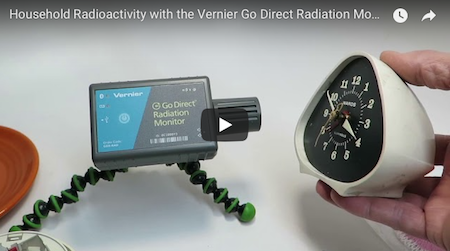The Vernier Go Direct Radiation Monitor: Well Worth the 90-Year Wait
By Martin Horejsi
Posted on 2018-03-19
Stephen Hawking died recently marking 2018 as another date in science history from which events will be measured. Isaac Newton was born in 1642, the same year Galileo died. And it is that 1642 date that is often used as a convenient moment in time to label as the birth of modern science. Three hundred years later in 1942 Stephen Hawking was born.

Stephen Hawking (1942-2018)
During Dr. Hawking’s academic life, he worked at the University of Cambridge in England, the same university, and in fact the same faculty position as Isaac Newton. On the ground of Cambridge University in the Department of Physics is the Cavendish Laboratory. And in the Cavendish Lab back in 1908, a fellow named Hans Geiger invented something that ultimately led to the creation of the Geiger–Müller tube in 1928. The Geiger–Müller tube is still used today in an instrument we all know and love called the Geiger Counter.

While the design of the Geiger–Müller tube or GM Tube has remained fairly consistent over the decades, the housing and electronics running the show have changed considerably. Early designs were crude but elegant in their simplicity, while the most popular expression of a Geiger Counter is the yellow box version with silver-tube handle commonly known as a Civil Defense Geiger Counter or CD Counter for short. Distributed widely during the Cold War years of the 1950s and 60s, the CD Counters are still found in high school physics classrooms, and were even passed out for free at NSTA conferences at the end of a presentation on how to use it.
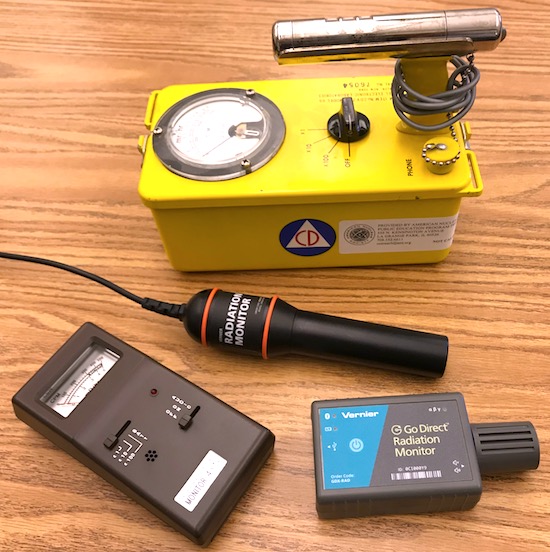
Today, however, there have been some remarkable advances in the design and electronics supporting the Geiger–Müller tube. In addition to a small lightweight housing, a rechargeable lithium battery weighing just a few grams can power the counter for hours compared to the five D-cell batteries used in the yellow box version. And since the function of the Geiger–Müller tube is to detect and share information on the number of ionizing radiation particles counted over time, the heavy duty analysis and data visualization can be outsourced to myriad of devices including smartphones (Grammar Girl says I can use ‘myriad’ that way). All that’s needed is a connection from the powered Geiger–Müller tube to the computing device.
For years a cable has served the purpose of connection the Geiger–Müller tube to a display of some sort. On the Civil Defense Counters, the Geiger–Müller tube is connected to the main box by a cord. Later Geiger Counters had built-in Geiger–Müller tubes along with their built-in meters, but also the ability connect to a computer with a cable. Then we moved to just the Geiger–Müller tube in a housing with a cable meaning that the Geiger Counter must be plugged into another device for it to work. And today we have the best of all worlds, a small, light Geiger Counter that has a rechargeable internal battery, a audio signal, a flashing light, a connection/charging cable, and a Bluetooth radio transmitter to physically de-tether the Geiger Counter from everything.
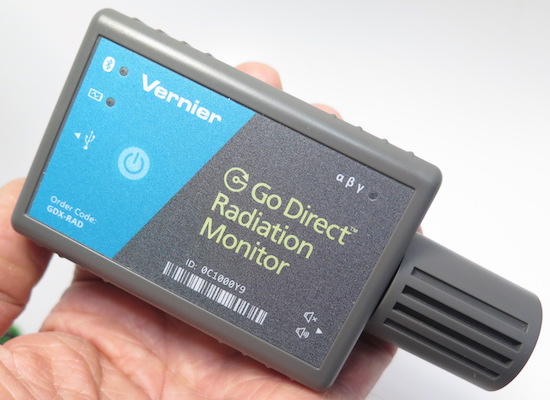
The Vernier Go Direct Radiation Monitor is at least the fourth in a timeline of Geiger Counters sold by the company over the years, and one of at least 30 different Go Direct sensors. This latest Geiger version is near a dream come true for me. Back when the iPhone was just taking off, the two big things I wanted on a smartphone were a Geiger Counter and a balance. I figured that the touch screen could be calibrated to also preform as a digital balance. While not yet available, the variable pressure touch screens make this feature seem possible. But the Go Direct Radiation Monitor is close enough to mark that one as done.
Using a small Geiger–Müller tube covered by the tradition mica window and protective screen, the Vernier Go Direct Radiation Monitor is familiar enough to other such devices to be recognizable and operational to anyone with previous Geiger Counter experience.
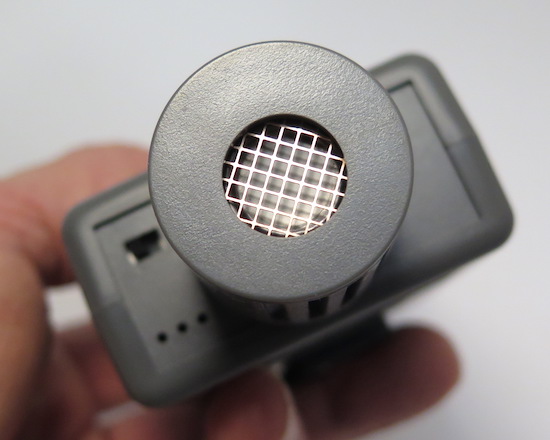
Power is provided by a 3.7v 300mAh lithium ion battery rechargeable through a standard micro-USB connection. And that same micro-USB port can also direct-connect the Vernier Go Direct Radiation Monitor to a computer or compatible tablet providing both power to the sensor and data to the computer. The battery is the same type used in almost all of the Go Direct sensors and Vernier.com offers a replacement is available for $9.
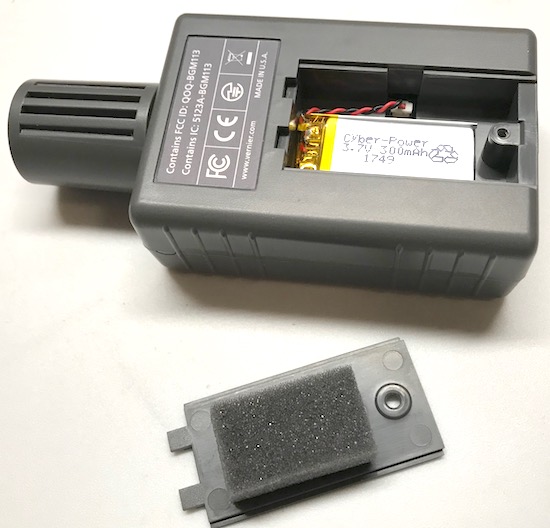
The real breakthrough here, and why I consider my quest for a smartphone/Geiger Counter over is that the Vernier Go Direct Radiation Monitor quickly and reliably connects to computing devices using a Low Energy Bluetooth 4.2 wireless connection. And now in hindsight, I was the pocket-superpowers that the Geiger Counter gives me, but not always in the exact same place as my $700 phone.
While the often-reported range of Bluetooth is about 10 meters, that is from the older version 3.x standard. Version 4.x Bluetooth has a maximum range of 60 meters and carries the same top speed of 25Mbit/s. There is a newer Bluetooth standard called version 5.x (launched June 2016) that doubles the speed and quadruples the range. But I’ve yet to test any v5.x Bluetooth products, and my near-antique iPhone 7 only has Bluetooth 4.2.
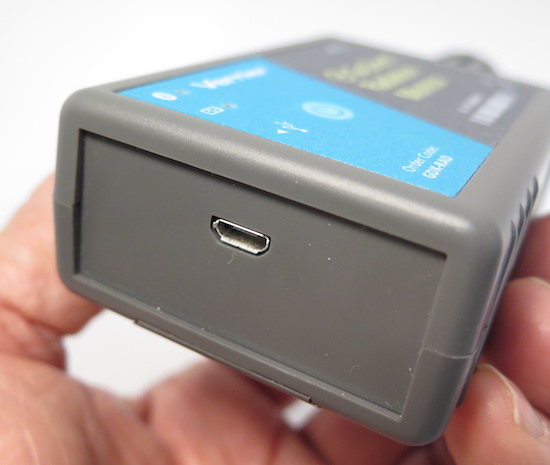
The controls on the Vernier Go Direct Radiation Monitor consist of one I/O button, one data/recharging port, one audio I/O switch, and three lights, one each for battery charge/charging, Bluetooth connectivity, and particle count. There is one main Geiger tube window, and access to the side of the tube housing for 90-degree analysis to separate the Alpha from the Beta. There is an identification code on the top of the sensor used to discriminate it from a classroom full of active Bluetooth devices. The underside has a single-screw battery housing door.
Connectivity to a computer using either Bluetooth or a cable is straightforward and effortless the second time. There are obviously separate instructions for connecting via Bluetooth and USB cable, but once the workflow is established, connecting the sensor is a non-issue and follows the protocols of Vernier wireless sensors. Compared other Bluetooth peripherals, however, there is a difference in that you make the initial Bluetooth link between your device and the sensor within the Graphical Analysis 4 App rather than in the Bluetooth system settings.
On the cabled side, the sensor will self-identify to the software so just plug in everything and turn it on. Details of software and hardware compatibility can be found on Vernier’s website.
The Vernier Go Direct Radiation Monitor works on mobile devices and computers (free Mac/PC/Chrome download here) through the Vernier App called Graphical Analysis 4. However, the Vernier Go Direct Radiation Monitor will flash and chirp just fine on its own in the presence of an ionizing radiation source.
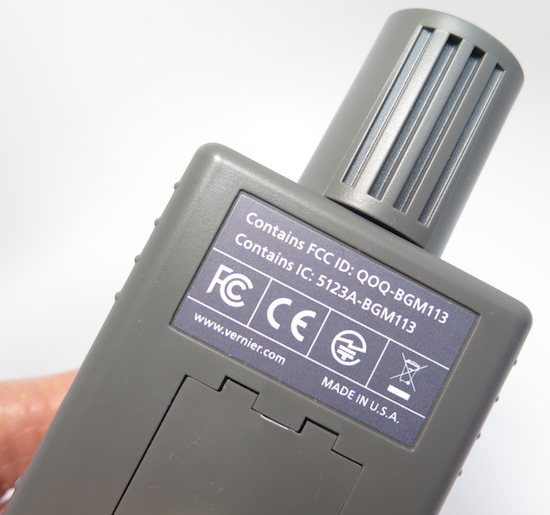
ɑ, β. ɣ. Oh My!
And speaking of ionizing radiation, its time for a brief science lesson. The term radiation has many uses and meanings, but the big scary one is when it applies to ionizing radiation. Common radiations (if that’s a word) include electromagnetics, particles, sound, and gravity. The one we are interested in with the Vernier Go Direct Radiation Monitor is ionizing radiation or particle radiation where there is enough energy to knock electrons off atoms thus ionizing them. The particle flying away at about 1/100 the speed of light or faster include Alpha Particles, Beta Particles, Gamma rays, and X-rays.
An Alpha particle (ɑ) contains two protons and two neutrons, or basically a helium-4 nucleus. But as big as they are, an Alpha can be stopped by skin, paper, and even a few dozen millimeters of air. It is that limited energy that can easily be used to indicate if the ionizing radiation is Alpha simply by inserting a mild barrier like a sheet of paper between the radioactive source and the business end of the Go Direct Radiation Monitor. If paper blocks the radiation, then Alpha is the likely type of particle.
Some popular uses of Alpha particle radiation include Radium-226 in cancer treatment, Polonium-210 in static eliminators, Americium-241 in smoke detectors, Plutonium-238 in pacemaker batteries and interplanetary spacecraft, and Strontium-90 in oceanic buoys and remote sensing stations.
Beta radiation (β) is more persistent than Alpha and may take a few millimeters of aluminum to get its attention. Since some source material emits both Beta and Gamma, a reduction in output might be noticed, but not a full stop. That indicates a dual Beta/Gamma output form your source.
Popular uses of Beta radiation sources include Tritium for making things glow in the dark like watches and gun sights, Carbon-14 as a radiotracer, Phosphorus-32 for short-lived research of DNA, and Nickel-63 in Radioisotope Piezoelectric Generators.
Gamma rays (ɣ) are different from Alpha and Beta particles in that Gamma rays are rays of penetrating electromagnetic radiation created during the radioactive decay of atomic nuclei. As a form of ionizing radiation, Gamma rays are much more biologically hazardous and should be treated thusly.
Sources of Gamma rays are two-fold. Radioactive decay can produce Gamma rays and Potassium-40 is a common source. But the real excitement with Gamma ray production is the those large-scale phenomena such as thunderstorms and their terrestrial gamma-ray flashes. Also cosmic rays, Pulsars, magnetars, Quasars, and cosmic Gamma-ray bursts from things like the birth of black holes and the death of stars in a supernova explosion (by the way, all of which are banned in public schools).
What is not banned in schools is background radiation. The Vernier Go Direct Radiation Monitor will detect background ionizing radiation at a rate of about one count (chirp or blink) every three to ten seconds. It usually won’t affect research results unless you are doing work at the top edge of this sensor’s pay grade. Vernier is clear that this sensor, and all of it’s products for that matter, are for educational use only. I did, however, find one radioactive source that required attention to background radiation. There is a material known as Trinitite that is essentially melted New Mexican desert through the explosion of the world’s first nuclear bomb code named Trinity.

Sixteen milliseconds after the Trinity bomb exploded.
Back in 1945 it was thought that Trinitie had formed from radiant thermal energy from the blast, thus it was deemed that Trinitite was safe for use in jewelry and other wearables. Although radioactive jewelry and watches have had a long and rich history with humans, Trinitite was the first time actual radioactive material from a nuclear explosion had found its way into ornamental fashions. Rather than the formation of Trinitite as just desert sand baked by the blast, recent research (2005) by scientists Robert Hermes and William Strickfaden into the creation of Trinitite found that “much of the mineral was formed by sand which was drawn up inside the fireball itself and then rained down in a liquid form.”
Let’s take a quick educational detour for a moment…
“Radium serves you safely and surely. The power of radium at your disposal”
-1921 advertisement for Undark Radium Luminous Paint.
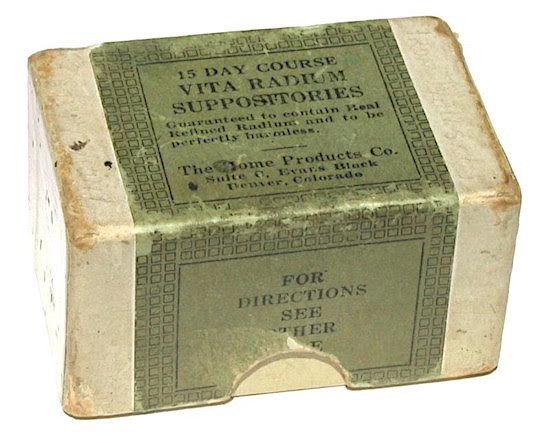
Two related and interesting side issues that can enrich the science curriculum are first, the tragic story of the “Radium Girls” who were employed to paint watch and clock faces (but also painted their own faces, teeth and fingernails) with radioactive radium. They worked on the assembly line until they were too sick to continue due to the effects of radiation poisoning. In the Radium Girls’ defense, they were instructed to shape their radium-covered paintbrush tips using their lips and tongue. The resulting lawsuits and litigation by the Radium Girls and other women in the radium painting industry lead to dramatic changes in American labor laws and occupational safety most notably from a 1938 lawsuit against the Radium Dial Company. Do note, however, that the use of radium to illuminate clock dials continued well into the 1960s but with worker-protections in place on the assembly line.
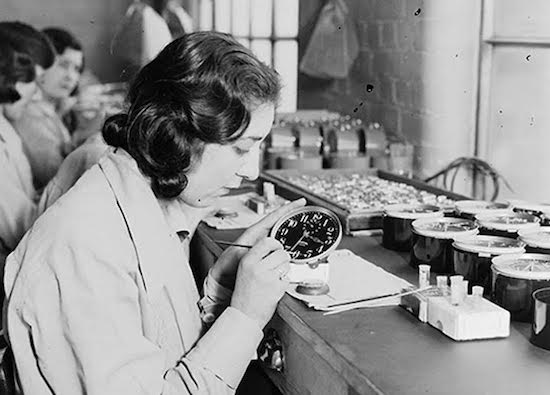
The second story revolves around a luxury Italian watch brand named Panerai. The advantage of the Panerai watch, for example over a Rolex, was that the bright glowing dial of the Panerai watch could be read in the dark. As the dangers of radioactivity became apparent, the watchmaker was in a pickle. Radium, and Panerai’s flagship watch, the Radiomir,” used radium and its 1600 year half-life to power the nighttime illumination. But customers were understandably concerned about wearing a strong gamma ray source on their wrist all day. With radium radioluminescence off the table, Panerai turned to Tritium, a less radioactive alternative, and renamed the watch the “Laminor.” And in 2009, Panerai again changed the formula of their famous glowing watch faces by using new strontium-based non-radioactive glowing material called Luminova.
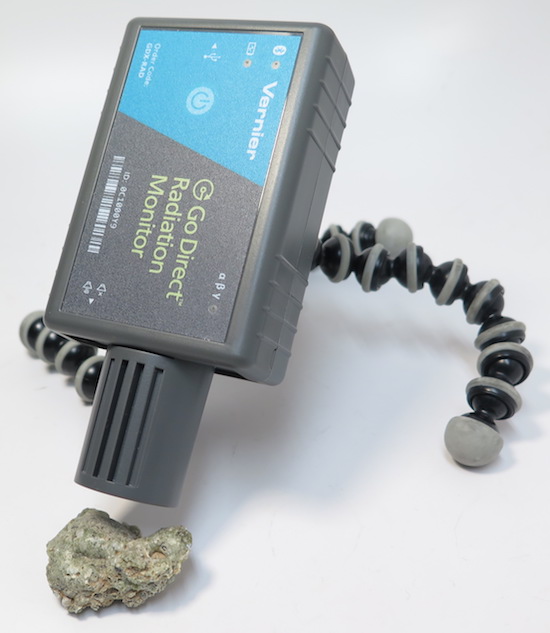
Back to Trinitite…
Placing the Vernier Go Direct Radiation Monitor near my specimen of Trinitie produced considerably more chirps and blinks than background radiation alone. But how much more? A few minutes with the Go Direct Radiation Monitor and my laptop and I had the answer. Background radiation was at six counts at the start (~1000m elevation). With the Trinitite next to the Vernier Go Direct Radiation Monitor’s screened window, the count rose to a high of 37 and a low of 25 over the minute of measurement. Then the count dropped to near one when the Trinitite was removed. But Vernier does mention in the instruction manual that background radiation counts can be as high as 25 meaning that there is a theoretical data-point-overlap between my lowest measured count and possible high count of ionizing radioactive background noise.
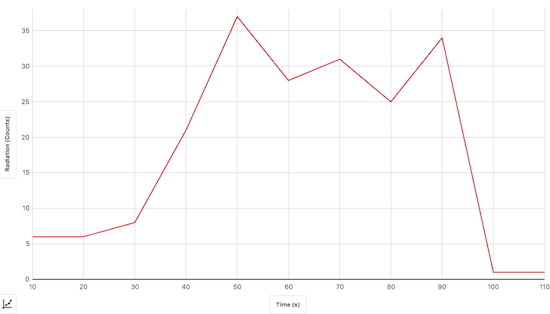
But the truth is always more complicated. The Alpha and Beta particles being tossed off by the Trinitite sample are low enough in count that there is little risk to humans as long as it remains outside the body. In fact it has been calculated that the danger of external Trinitite exposure is less than one BED unit, or Banana Equivalent Dose. But unlike the banana, if you ate the Trinitite your chances of heath complications like bone cancer in particular go way up. A Beta emitter in Trinitite is Strontium-90, also known as the “Bone Seeker” due to its behavior similar to calcium in the human body, and therefore could be cumulatively stored in bones.

Of course there are significant flaws to generalizing bananas to radioactive exposure, but the humor and potential shock value do come in handy when teaching about the subject. Another “BED” could be the Brazil Nut which contains not only the potassium-40 found in bananas, but also radium found in early generation Panerai watches.
And speaking of radioactivity, the term was coined by Marie Curie who happens to be the first woman to win a Nobel Prize (physics 1903), the first person and only woman to ever win the Nobel Prize twice (chemistry 1911), and the only person to win the Nobel Prize in two different sciences. But wait, there’s more. Her husband Frédéric shared the 1903 prize with her. Their daughter Irène won the Nobel Prize for chemistry in 1935 together with her husband. And the Curie’s second daughter’s husband Henry Labouisse was the director of UNICEF when that organization won the 1965 Nobel Peace Prize. Just imagine the Curie family dinner conversations over the years!
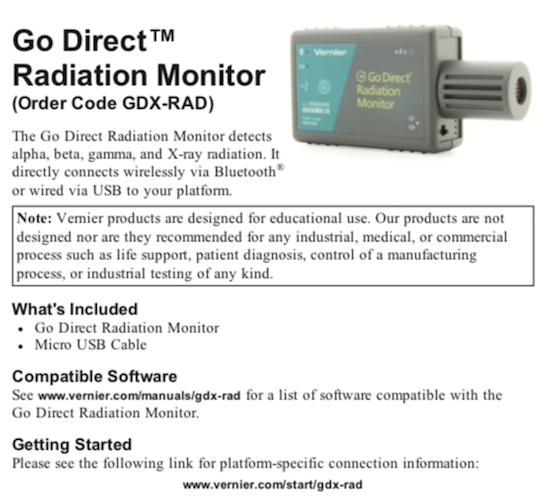
The Vernier Go Direct Radiation Monitor instruction manual is available here. It contains the following passages about using the sensor:
To measure gamma and X-rays, hold the tip of the Go Direct Radiation Monitor toward the source of radiation. Low-energy gamma radiation (10–40 KeV) cannot penetrate the side of the GM tube, but may be detected through the end window.
To detect alpha radiation, position the monitor so the suspected source of radiation is next to the GM window. Alpha radiation will not travel far through air, so put the source as close as possible (within 1/4″) to the screen without touching it. Even a humid day can limit the already short distance an alpha particle can travel.
To detect beta radiation, point the end window toward the source of radiation. Beta radiation has a longer range through air than alpha particles, but can usually be shielded (e.g., by a few millimeters of aluminum). High energy beta particles may be monitored through the back of the case.
To determine whether radiation is alpha, beta, or gamma, hold the tip of the monitor toward the specimen. If there is an indication of radioactivity, it is most likely gamma or high energy beta. Place a piece of aluminum about 3 mm (1/8″) thick between the case and the specimen. If the indication stops, the radiation is most likely beta. (To some degree, most common radioactive isotopes emit both beta and gamma radiation.) If there is no indication through the back of the case, position the end window close to, but not touching, the specimen. If there is an indication, it is probably alpha or beta. If a sheet of paper is placed between the window, and the indication stops, the radiation is most likely alpha. In order to avoid particles falling into the instrument, do not hold the specimen directly above the end window.
The Radiation Monitor does not detect neutron, microwave, radio frequency (RF), laser, infrared, or ultraviolet radiation. Some isotopes it will detect relatively well are cesium-137, cobalt-60, technicium-99m, phosphorus-32, and strontium-90.
Some types of radiation are very difficult or impossible for this GM tube to detect. Beta emissions from tritium are too weak to detect using the Radiation Monitor. Americium-241, used in some smoke detectors, can overexcite the GM tube and give an indication of a higher level of radiation than is actually present.
And speaking of X-rays, I cannot wait until my next flight. I hope to run the Vernier Go Direct Radiation Monitor through the TSA X-ray machine while collecting data on my iPhone. Of course I’ll continue to take measurements while flying as well, which, by the way, is a thing and happens to be a global flying pastime genre on Youtube including one of my earlier videos I posted back in 2011 called simply “Flight radiation.” Perhaps the boring name is why it’s been watched only 96 times in its seven years on Youtube.
A basic understanding of ionizing radiation is important now more than ever since the potential for encountering a source of radiation, whether in medicine or terrorism, is both a reality of 21st century life and completely undetectable by human senses. Additionally, the quantity of misinformation about ionizing radiation, and even just radiation in general is not limited to the overall population. Schools are doing their part as well. But that latter point is easily remedied, and with that cure society will follow.
The EPA.gov has an excellent collection of information about both ionizing and non-ionizing radiation. Here are a couple excerpts addressing dangers and health:
Regarding Alpha particles:
The health effect from exposure to alpha particles depends greatly on how a person is exposed. Alpha particles lack the energy to penetrate even the outer layer of skin, so exposure to the outside of the body is not a major concern. Inside the body, however, they can be very harmful. If alpha-emitters are inhaled, swallowed, or get into the body through a cut, the alpha particles can damage sensitive living tissue. The way these large, heavy particles cause damage makes them more dangerous than other types of radiation. The ionizations they cause are very close together – they can release all their energy in a few cells. This results in more severe damage to cells and DNA.
Regarding Beta Particles:
Beta particles are more penetrating than alpha particles, but are less damaging to living tissue and DNA because the ionizations they produce are more widely spaced. They travel farther in air than alpha particles, but can be stopped by a layer of clothing or by a thin layer of a substance such as aluminum. Some beta particles are capable of penetrating the skin and causing damage such as skin burns. However, as with alpha-emitters, beta-emitters are most hazardous when they are inhaled or swallowed.
And regarding Gamma rays:
Gamma rays are a radiation hazard for the entire body. They can easily penetrate barriers that can stop alpha and beta particles, such as skin and clothing. Gamma rays have so much penetrating power that several inches of a dense material like lead, or even a few feet of concrete may be required to stop them. Gamma rays can pass completely through the human body; as they pass through, they can cause ionizations that damage tissue and DNA.

In addition to the pair of radiation monitors Vernier offers, there is also a freely downloadable book titled Nuclear Radiation with Vernier. This 96 page PDF book was published in 2016 and contains six lab exercises. Along with the digital book are several other folders in the download including instructor information with answers to the questions, and student worksheets.
Vernier offers a few more exciting things you can do with the Go Direct Radiation Monitor on their website under the heading Lab Ideas and Innovative Uses. One idea, “An Inexpensive Beta Radiation Spectrometer” is listed on the Go Direct Radiation Monitor page and seven more links to innovative uses are found on the cabled version of the radiation monitor. Make sure to check out the one named “LabQuest 2 on a Balloon Flight Near Space.” Remarkable!

As mentioned before, this is at least the fourth radiation sensor product Vernier has offered. Currently there are two radiation sensors actively listed on the Vernier website; this Go Direct Radiation Sensor, and a cabled Vernier Radiation Monitor. Only $10 separates the two with the Go Direct commanding the extra Hamilton.
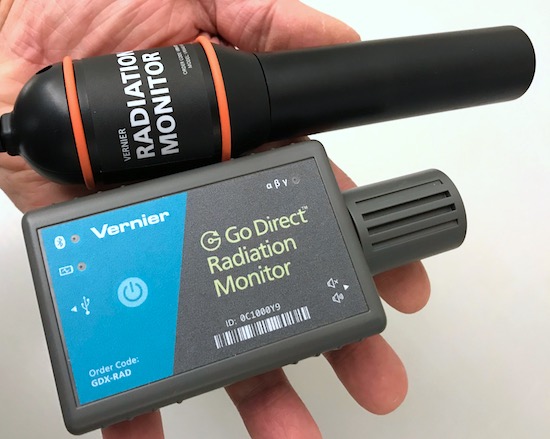
The Vernier Go Direct Radiation Monitor weighs 94 grams or about one-half of the weight of my iPhone 7 in a basic case. The monitor measures about three centimeters thick, six centimeters wide, and 12cm from base to snout. So at about half the density of water, the Vernier Go Direct Radiation Monitor will most certainly float for a while. But do not immerse the Vernier Go Direct Radiation Monitor to water. If water does get into the sensor, Vernier recommends immediately disconnecting and powering down the sensor and allowing it to fully dry before restarting it.
The smooth plastic housing of the Vernier Go Direct Radiation Monitor is somewhat slippery. Given the portability-encouraging design, I would like to have a silicon armor case around the sensor for field work and transportation.
And while making suggestions for improvement, it would be nice to see a tripod socket on the underside of the Vernier Go Direct Radiation Monitor for both laboratory staging, and to add distance between sensor and scientist. Looking at the sensor’s design, it would be very easy to make both silicon case, and an aftermarket battery cover containing a tripod screw hole. In the meantime I can just use a smartphone holder that mounts on a tripod. Or…maybe not.
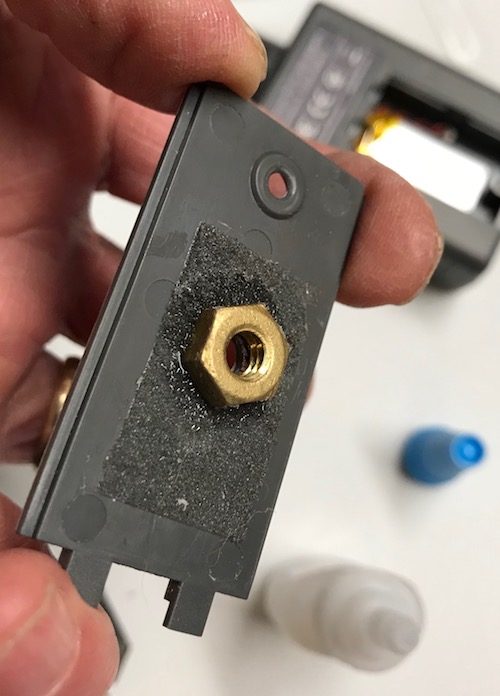
Upon closer inspection it seems there is plenty of room in the battery compartment for a tripod screw to spin in to. Like many electronics these days, much of the internal volume of the box is full of air. So I pulled out my drill and went to work. To make a tripod socket I first removed the battery cover, then the foam padding that keeps the small battery from bouncing around in its large housing. Then I drilled a 15/64 inch hole into the center of the battery compartment lid. Then I used a 1/4 inch tap to thread the hole in the plastic. A standard 1/4-20 tripod-threaded nut was superglued to the inside of the case with it’s threads aligned with those tapped into the plastic lid. Although there is little additional strength of the threaded plastic compared to the metal nut, I don’t have the heart to deliberately strip out the plastic, nor use a drill bit larger than necessary.
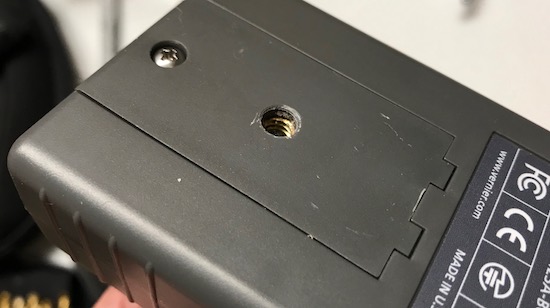
After replacing the foam, I’m not worried that the hole will allow anymore of the universe to get into the sensor body than before because the battery cover is neither airtight nor watertight. The overall result was a good mod (teen-talk for a modification) that increased the sensor’s mounting capability and added to the many ways the sensor can be used. To really leverage the detethering of Bluetooth, the number of attachment options needs to be maximized. However, I do suspect that I may have voided the five-year warranty of the sensor (one year on the G-M tube). Or at a minimum the warranty of the battery cover. If I were redoing this mod, I think I would move the tripod socket hole forward of door-center by a centimeter or two placing it closer to the balance point of the sensor.
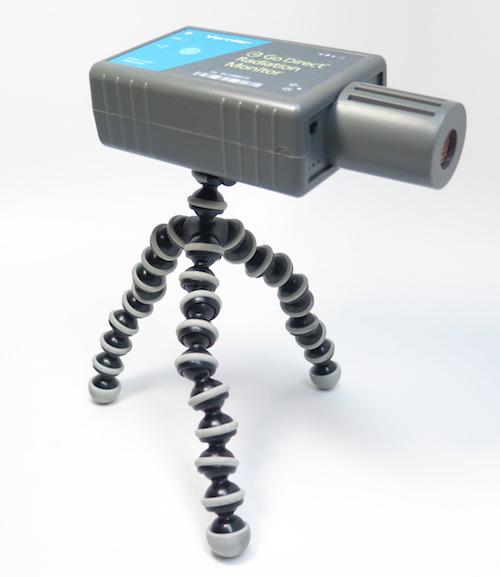
With the Vernier Go Direct Radiation Monitor sitting atop a small tripod, I found the look a little similar to the three-legged tripod alien “Fighting Machines” in H. G. Wells’ 1898 book War of the Worlds, a story Stephen Hawking was no doubt familiar. War of the Worlds is about Martians landing on earth in search of resources. Using their fighting machines, the aliens inadvertently started the popular literary genre of humans fighting machines (the origins of the word ‘robot’ was still two decades away).
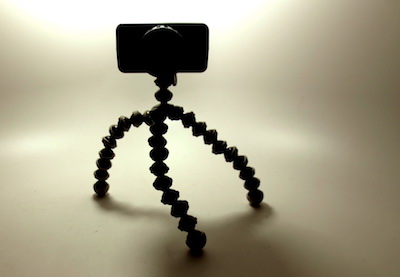

At the Zeitgeist 2015 conference in London, Stephen Hawking said, “Computers will overtake humans with AI at some time within the next 100 years. When that happens, we need to make sure the computers have goals aligned with ours.”
This was not the first foray into this man vs machine realm for Dr. Hawking. Earlier in 2015 Stephen Hawking added his name to an open letter titled Research Priorities for Robust and Beneficial Artificial Intelligence. You can read the letter here. And add your name to the 8000+ names already included. The letter ends with, “In summary, we believe that research on how to make AI systems robust and beneficial is both important and timely, and that there are concrete research directions that can be pursued today.”
In my dream of having a smarter smartphone through the addition of a Geiger Counter, something I would always have with me, and can use in the classroom with almost no technology-overhead chewing up precious instructional time, I also run the risk of moving further down the rabbit hole of relying on technology to teach. At the moment I am going to follow the path and the priorities that Stephen Hawking envisioned for AI as long as the educational technologies have their goals aligned with ours.
In the meantime, it’s becoming evermore clear that Vernier’s Go Direct theme of Bluetooth transmitting, self-contained, self-powered, self-identifying (but not yet self-aware) sensors are not just another evolutionary branch on the probeware tree, but, in fact, the Go Direct family is an entirely new species of instructional technology that has the potential to cause a global pandemic of effective science education.

Disclaimer: The views expressed in this blog post are those of the author(s) and do not necessarily reflect the official position of the National Science Teaching Association (NSTA).



